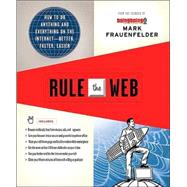
Note: Supplemental materials are not guaranteed with Rental or Used book purchases.
Purchase Benefits
What is included with this book?
| Introduction | p. xi |
| Creating and Sharing | p. 1 |
| Web Sites | p. 1 |
| Blogs | p. 13 |
| Podcasting | p. 36 |
| Wikis | p. 52 |
| Social Networking | p. 58 |
| Photography and Video | p. 60 |
| Sharing | p. 72 |
| Searching and Browsing | p. 77 |
| Searching | p. 77 |
| Browsing | p. 90 |
| Shopping and Selling | p. 111 |
| Auctions | p. 111 |
| Shopping | p. 121 |
| Health, Exercise, and Sports | p. 135 |
| Health and Medicine | p. 135 |
| Media and Entertainment | p. 143 |
| News and Information | p. 143 |
| Music | p. 152 |
| Video and Movies | p. 161 |
| Games | p. 178 |
| Books | p. 190 |
| Sports | p. 203 |
| Travel and Sightseeing | p. 207 |
| Work, Organization, and Productivity | p. 217 |
| Personal Productivity | p. 217 |
| Money and Finance | p. 223 |
| Communication | p. 239 |
| Wireless Computing | p. 239 |
| Connecting on the Road | p. 251 |
| Mobile Phones | p. 256 |
| Internet Phones | p. 272 |
| Landline Phones | p. 281 |
| p. 283 | |
| Toolbox | p. 309 |
| System Tune-up | p. 309 |
| Music | p. 320 |
| Video and Movies | p. 340 |
| Personal Productivity | p. 345 |
| Protecting and Maintaining | p. 351 |
| Security and Privacy | p. 351 |
| Maintenance | p. 376 |
| Tips from my Favorite Bloggers | p. 379 |
| Acknowledgments | p. 393 |
| Index | p. 335 |
| Table of Contents provided by Ingram. All Rights Reserved. |
The New copy of this book will include any supplemental materials advertised. Please check the title of the book to determine if it should include any access cards, study guides, lab manuals, CDs, etc.
The Used, Rental and eBook copies of this book are not guaranteed to include any supplemental materials. Typically, only the book itself is included. This is true even if the title states it includes any access cards, study guides, lab manuals, CDs, etc.
Excerpted from Rule the Web: How to Do Anything and Everything on the Internet--Better, Faster, Easier by Mark Frauenfelder
All rights reserved by the original copyright owners. Excerpts are provided for display purposes only and may not be reproduced, reprinted or distributed without the written permission of the publisher.